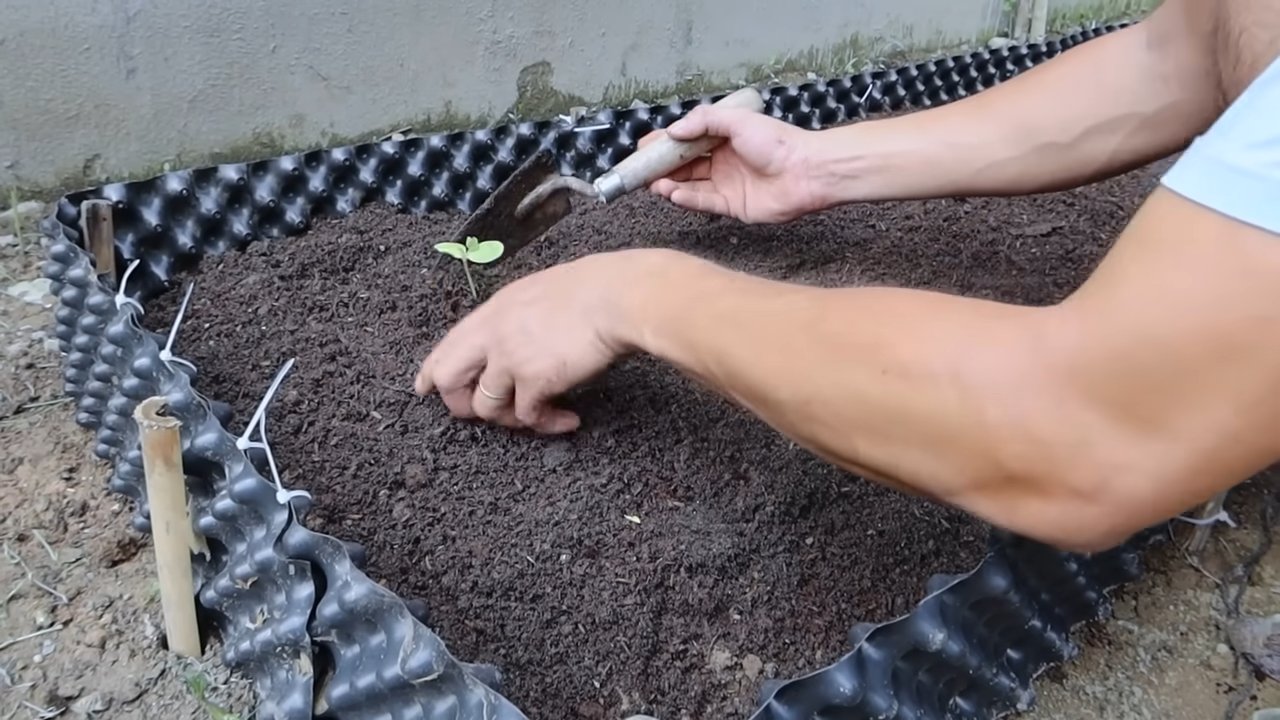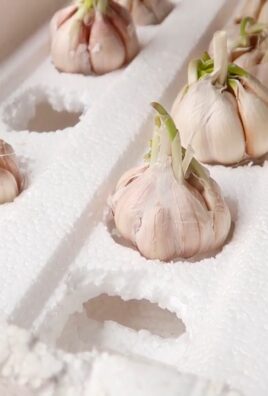Grow Square Watermelons at Home? Absolutely! Forget the round ones rolling all over your fridge – we’re diving into the quirky and surprisingly simple world of shaping your watermelons into perfect squares. Have you ever seen those perfectly cubed watermelons in high-end grocery stores and wondered how they achieve such geometric perfection? It’s not magic, my friends, but a clever gardening trick that you can easily replicate in your own backyard!
While the exact origins are debated, the practice of shaping fruits and vegetables has roots in Japanese agriculture, where farmers have long sought innovative ways to maximize space and create visually appealing produce. These square watermelons aren’t just a novelty; they’re easier to stack, transport, and even cut, making them a practical choice for urban gardeners and those with limited space.
Why should you try this DIY trick? Well, besides the sheer fun of it, growing square watermelons at home is a fantastic conversation starter, a unique gift idea, and a great way to impress your friends and family. Plus, it’s a fantastic learning experience for kids, teaching them about plant growth and the ingenuity of gardening techniques. I’m excited to show you how to easily grow square watermelons at home with just a few simple materials and a little patience. Let’s get started and transform your watermelon patch into a geometric wonderland!

How to Grow Square Watermelons: A Fun DIY Project!
Okay, let’s be honest, who wouldn’t want to grow a square watermelon? It’s a total conversation starter, a fun project for kids, and surprisingly easy to do! I’m going to walk you through the whole process, from choosing the right watermelon to crafting the perfect mold. Get ready to impress your friends and family with your unique harvest!
What You’ll Need
Before we dive in, let’s gather our supplies. This is a pretty straightforward project, so you probably have a lot of this stuff already.
* Watermelon Seeds or Seedlings: Choose a variety known for its smaller size and relatively thin rind. Sugar Baby or similar varieties work great.
* Clear Acrylic or Polycarbonate Box: This is your mold! The size depends on how big you want your square watermelon to be. A 8x8x8 inch box is a good starting point. Make sure it’s clear so sunlight can reach the watermelon.
* Drill with Drill Bits: For creating ventilation and drainage holes in your mold.
* Small Saw or Cutting Tool: To create an opening in the box large enough to slip the watermelon vine through.
* Zip Ties or Strong Tape: To secure the box around the watermelon.
* Gloves: To protect your hands.
* Measuring Tape or Ruler: For accurate measurements.
* Well-Draining Soil: Watermelons need good drainage to thrive.
* Fertilizer: A balanced fertilizer to support healthy growth.
* Watering Can or Hose: For regular watering.
* Patience: This is key! It takes time and care to grow a square watermelon.
Choosing the Right Watermelon Variety
Not all watermelons are created equal when it comes to square-growing potential. You want a variety that’s relatively small and has a thinner rind. This makes it easier for the watermelon to conform to the shape of the mold.
* Sugar Baby: This is a classic choice. It’s small, sweet, and matures relatively quickly.
* Golden Midget: Another good option for smaller watermelons.
* Bush Sugar Baby: If you’re short on space, this compact variety is perfect.
Avoid larger varieties like Charleston Gray or Crimson Sweet, as they might outgrow your mold too quickly.
Building Your Watermelon Mold
This is where the magic happens! The mold is what will give your watermelon its square shape.
1. Assemble the Box: If you bought a flat-pack acrylic or polycarbonate box, assemble it according to the instructions. Make sure all the sides are securely joined.
2. Drill Ventilation Holes: Drill several small holes (about ¼ inch) in the top and sides of the box. This is crucial for ventilation and to prevent the watermelon from overheating or developing mold.
3. Drill Drainage Holes: Drill a few larger holes (about ½ inch) in the bottom of the box for drainage. Watermelons don’t like sitting in soggy soil.
4. Create an Opening for the Vine: Using your saw or cutting tool, carefully cut a semi-circular opening in one side of the box. This opening needs to be large enough to slip the watermelon vine through without damaging it. Aim for an opening about 2-3 inches in diameter.
5. Smooth the Edges: Use sandpaper or a file to smooth any sharp edges around the opening. This will prevent the vine from getting scratched or damaged.
Planting and Growing Your Watermelon
Now for the fun part – getting those seeds in the ground!
1. Prepare the Soil: Watermelons need well-draining soil that’s rich in organic matter. Amend your soil with compost or aged manure to improve drainage and fertility.
2. Plant Your Seeds or Seedlings: Follow the instructions on your seed packet or seedling label for spacing and planting depth. Watermelons need plenty of space to spread out.
3. Water Regularly: Keep the soil consistently moist, but not waterlogged. Water deeply whenever the top inch of soil feels dry.
4. Fertilize: Feed your watermelon plants with a balanced fertilizer every few weeks. Follow the instructions on the fertilizer label.
5. Provide Support: As the vines grow, you may need to provide some support to keep the watermelons off the ground. Use trellises or stakes to support the vines.
Putting the Mold on the Watermelon
This is the trickiest part, so take your time and be gentle!
1. Choose the Right Watermelon: Wait until the watermelon is about 4-6 inches in diameter before putting the mold on. It should be firm and healthy-looking.
2. Carefully Position the Box: Gently slip the box over the watermelon, making sure the vine passes through the opening you created. Be careful not to damage the vine or the watermelon.
3. Secure the Box: Use zip ties or strong tape to secure the box around the watermelon. Make sure the box is snug but not too tight. You don’t want to restrict the watermelon’s growth.
4. Monitor the Watermelon: Check the watermelon regularly to make sure it’s growing properly. If you notice any signs of stress, such as wilting or discoloration, loosen the box slightly.
5. Adjust as Needed: As the watermelon grows, you may need to adjust the box or add additional support.
Caring for Your Square Watermelon
Once the mold is on, it’s important to continue providing proper care to ensure a healthy and successful harvest.
1. Water Regularly: Continue to water deeply whenever the top inch of soil feels dry.
2. Fertilize: Continue to feed your watermelon plants with a balanced fertilizer every few weeks.
3. Monitor for Pests and Diseases: Keep an eye out for common watermelon pests and diseases, such as aphids, squash bugs, and powdery mildew. Treat any problems promptly.
4. Provide Shade: In very hot climates, you may need to provide some shade to protect the watermelon from sunburn.
5. Be Patient: It takes time for a watermelon to grow to its full size. Be patient and don’t remove the mold prematurely.
Harvesting Your Square Watermelon
The moment you’ve been waiting for!
1. Check for Ripeness: Watermelons are typically ready to harvest when the tendril closest to the fruit turns brown and dry. The underside of the watermelon (where it rests on the ground) should also turn from white to yellow.
2. Remove the Mold: Carefully remove the zip ties or tape and gently lift the box off the watermelon.
3. Harvest the Watermelon: Use a sharp knife to cut the watermelon from the vine, leaving a few inches of stem attached.
4. Admire Your Creation: You did it! You grew a square watermelon!
Troubleshooting Tips
Even with the best planning, things can sometimes go wrong. Here are a few common problems and how to fix them:
* Watermelon Rotting Inside the Mold: This is usually caused by poor ventilation or drainage. Make sure you have enough ventilation and drainage holes in the box. You can also try removing the box for a few hours each day to allow the watermelon to air out.
* Watermelon Cracking: This can be caused by inconsistent watering or rapid growth. Make sure you’re watering regularly and avoid over-fertilizing.
* Watermelon Not Filling the Mold: This could be due to a variety of factors, such as poor soil, inadequate sunlight, or the wrong watermelon variety. Make sure you’re providing optimal growing conditions.
* Pests and Diseases: Treat any pest or disease problems promptly to prevent them from affecting the watermelon’s growth.
Tips for Success
Here are a few extra tips to help you grow the perfect square watermelon:
* Start with Healthy Plants: Choose healthy seeds or seedlings from a reputable source.
* Provide Plenty of Sunlight: Watermelons need at least 6-8 hours of sunlight per day.
* Water Deeply and Regularly: Watermelons need consistent moisture to thrive.
* Fertilize Regularly: Feed your watermelon plants with a balanced fertilizer every few weeks.
* Be Patient: Growing a square watermelon takes time and care. Don’t get discouraged if things don’t go perfectly the first time.
Growing square watermelons is a fun and rewarding project that anyone can do. With a little planning and effort, you can impress your friends and family with your unique harvest. Good luck, and happy growing!

Conclusion
Growing square watermelons at home might seem like a novelty, but it’s so much more than just a fun gardening project. It’s a testament to the ingenuity of home gardeners and a fantastic way to impress your friends and family. Beyond the visual appeal, the square shape offers practical advantages: they stack neatly in the refrigerator, take up less space during transport, and are easier to cut and serve. This DIY trick transforms the ordinary into the extraordinary, adding a touch of whimsy and practicality to your summer harvest.
But the real magic lies in the process. Nurturing your watermelon from a tiny seedling to a perfectly formed square fruit is incredibly rewarding. It connects you to the natural world in a tangible way, teaching patience, observation, and the delicate balance of gardening. Plus, imagine the conversations sparked when you present a square watermelon at your next barbecue!
Don’t be afraid to experiment with variations. While the basic method remains the same, you can adjust the size of the mold to create different sized square watermelons. You could even try using different materials for the mold, although clear acrylic or polycarbonate remains the most effective for light penetration and visibility. Consider painting the inside of the mold white to further maximize light reflection and ensure even ripening.
For those seeking an extra challenge, explore growing other fruits and vegetables in unique shapes. Cucumbers, pumpkins, and even tomatoes can be molded into various forms, opening up a world of creative gardening possibilities. The key is to start with a young fruit and a mold that allows for adequate growth and airflow.
Ultimately, the success of this project hinges on your dedication and attention to detail. Regular watering, proper fertilization, and careful monitoring of the watermelon’s growth within the mold are crucial. But even if your first attempt isn’t perfect, don’t be discouraged. Gardening is a learning process, and each attempt brings you closer to mastering the art of growing square watermelons.
So, are you ready to embark on this exciting gardening adventure? We wholeheartedly encourage you to try this DIY trick and experience the joy of growing your own square watermelons at home. It’s a project that combines creativity, practicality, and a deep connection to nature. And most importantly, don’t forget to share your experiences with us! We’d love to see your square watermelon creations and hear about any tips or tricks you discover along the way. Post photos and stories of your success (or even your hilarious failures!) in the comments section below. Let’s build a community of square watermelon enthusiasts and inspire others to try this unique and rewarding gardening project. Let’s get growing and show the world the amazing things that can be achieved with a little ingenuity and a lot of love for gardening. This **DIY trick** is a game changer!
Frequently Asked Questions (FAQ)
What type of watermelon is best for growing in a square mold?
The best watermelons for growing in square molds are smaller, personal-sized varieties like Sugar Baby, Yellow Doll, or Golden Midget. These varieties tend to ripen faster and fit more comfortably within the confines of a standard-sized mold. Avoid larger varieties like Charleston Gray or Jubilee, as they may outgrow the mold before they fully ripen, potentially damaging the fruit or the mold itself. Consider the growing season length in your area when selecting a variety, ensuring it has enough time to mature before the first frost.
How do I choose the right size mold for my watermelon?
The ideal mold size depends on the variety of watermelon you’re growing. As a general rule, choose a mold that is slightly smaller than the expected mature size of the watermelon. This will allow the watermelon to fill the mold completely, resulting in a well-defined square shape. For personal-sized watermelons, a mold that is approximately 8 inches by 8 inches by 8 inches is usually sufficient. Remember to account for the thickness of the mold material when determining the internal dimensions.
When is the best time to place the watermelon in the mold?
The optimal time to place the watermelon in the mold is when it is approximately 4-6 inches in diameter. At this stage, the watermelon is still actively growing but is small enough to comfortably fit inside the mold without being overly constricted. Avoid placing the watermelon in the mold too early, as it may not have enough room to develop properly. Similarly, waiting too long may result in the watermelon becoming too large to fit inside the mold without causing damage.
How do I prevent the watermelon from rotting inside the mold?
Preventing rot is crucial for successful square watermelon cultivation. Ensure the mold has adequate ventilation holes to allow for airflow and prevent moisture buildup. Regularly inspect the watermelon for any signs of rot or disease, such as soft spots or discoloration. If you notice any problems, remove the watermelon from the mold immediately. Avoid overwatering, as this can create a humid environment that promotes fungal growth. Consider applying a fungicide specifically formulated for watermelons to help prevent disease.
How long does it take for a watermelon to ripen inside the mold?
The ripening time inside the mold is generally the same as the ripening time for watermelons grown without a mold, which is typically 30-50 days after fruit set, depending on the variety and growing conditions. However, it’s essential to monitor the watermelon closely for signs of ripeness, such as a change in color, a dull thud when tapped, and a dried tendril near the stem. Remember that the mold may slightly delay the ripening process due to reduced sunlight exposure.
Can I reuse the mold for multiple watermelons?
Yes, you can reuse the mold for multiple watermelons, provided it is properly cleaned and disinfected between uses. Wash the mold thoroughly with soap and water to remove any dirt or debris. Then, disinfect it with a solution of bleach and water (1 part bleach to 9 parts water) to kill any bacteria or fungi. Rinse the mold thoroughly with clean water before using it again. Inspect the mold for any cracks or damage before each use, and replace it if necessary.
Will the square shape affect the taste of the watermelon?
The square shape itself will not affect the taste of the watermelon. The taste is primarily determined by the variety of watermelon, the growing conditions, and the ripeness of the fruit. However, the mold may slightly reduce the amount of sunlight that reaches the watermelon, which could potentially affect the sugar content and overall flavor. To mitigate this, choose a clear or translucent mold material and ensure the watermelon receives adequate sunlight exposure.
What if the watermelon gets stuck in the mold?
If the watermelon gets stuck in the mold, do not force it out, as this could damage the fruit. Instead, carefully loosen the mold by gently tapping it with a rubber mallet. If the watermelon is still stuck, try lubricating the inside of the mold with a small amount of vegetable oil or petroleum jelly. Be patient and persistent, and eventually, the watermelon should come loose. If all else fails, you may need to carefully cut the mold open to remove the watermelon.
Are there any risks associated with growing watermelons in molds?
Yes, there are a few risks associated with growing watermelons in molds. The most common risk is rot or disease, which can occur if the mold is not properly ventilated or if the watermelon is overwatered. Another risk is that the watermelon may outgrow the mold, causing it to crack or break. Additionally, the mold may attract pests or insects, which can damage the watermelon. To minimize these risks, choose a well-ventilated mold, monitor the watermelon closely, and take appropriate pest control measures.
Where can I buy a watermelon mold?
Watermelon molds can be purchased online from various retailers, including Amazon, eBay, and specialty gardening stores. You can also find them at some local garden centers or nurseries. When purchasing a mold, be sure to choose one that is made of durable, food-grade material and has adequate ventilation holes. Read customer reviews to get an idea of the mold’s quality and performance.





Leave a Comment